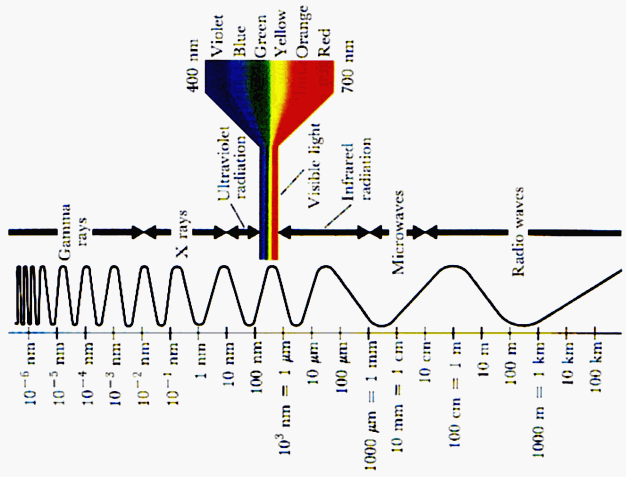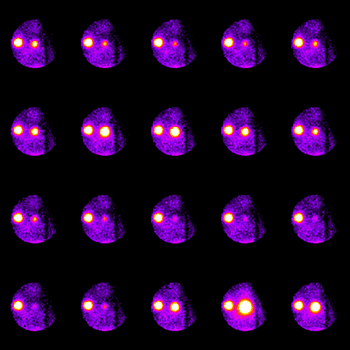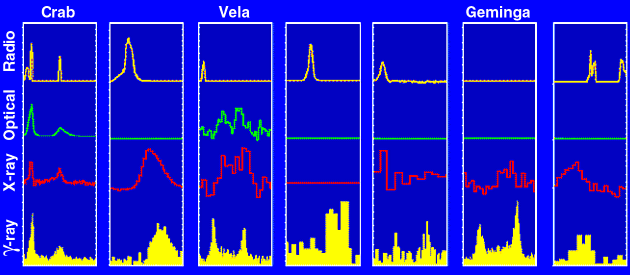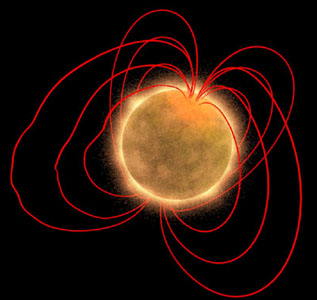7. Pulsars at Other Wavelengths
Pulsars were discovered at radio frequencies and this is still the way we learn most about their population and properties. This is the case despite the fact that the energy emitted in the radio regime is only a tiny fraction (typically one millionth or so) of the total loss in rotational energy. However, recent advances in high energy astronomy, in particular with the advent of new X-ray satellites like ROSAT or, more recently, XMM or Chandra, have opened up new large windows to study these exciting objects. In these parts of the electromagnetic spectrum, the energy output is typically a few percent of the spin-down luminosity.
Moving in the electromagnetic
spectrum from radio to shorter wavelengths (i.e. higher frequencies) we
first pass infrared emission, then the short range of the visible spectrum,
then ultraviolet radiation before we reach X-rays and finally gamma rays, Figure 1.

|
|
Figure 1. The electromagnetic spectrum. |
While the large majority of pulsars have only been detected in the radio regime, an increasing number are now also detected at optical frequencies, and in particular at X-rays. The Crab pulsar is again something special, as it is detectable across the whole electromagnetic spectrum. The origin of the emission from pulsars in other parts of the electromagnetic spectrum usually has a different origin than in the radio regime, as we will now discuss.
7.1 Optical observations

|
|
Figure 2. This sequence of optical images shows the various phases of the Crab pulsar rotation as observed by A. Golden and co-workers. The optical pulses of the Crab pulsar can be compared to the reference star to the west (the star on the right, see also the optical image shown in Part 1 of these notes). |
Only a handful of pulsars are detected in the optical regime. For most of these sources still, one only observes a star-like point source at the position of the pulsar. That means that as long as individual optical pulses cannot be observed, the object could still be an ordinary star which happens to be located along the line of sight to the pulsar. One way to distinguish between such a case and a genuine pulsar detection is to study the spectrum and the properties of the emission. If the optical emission happens to be polarized, it can be fairly safely assumed that the emission is originating from the pulsar magnetosphere in the form of optical synchrotron emission. If the emission appears to be blackbody radiation, the likely cause is a positional coincidence with an ordinary star. However, there is also a chance that one has detected the hot surface of the neutron star. But since the temperature of the surface is of the order of a few million Kelvin, the peak of this radiation should be expected in the ultraviolet or X-ray regime.
The optical emission of
the Crab pulsar had been observed as a strange star in
the centre of the Crab nebula long before the pulsar was identified as
such. Indeed, the Crab pulsar is the prime example of a radio pulsar also
emitting pulses in the optical regime, Figure 2.
 An animation of the optical Crab pulsar observations
(made by A. Golden).
An animation of the optical Crab pulsar observations
(made by A. Golden).
|
7.2 X-ray observations
About 40 pulsars have been detected at X-ray frequencies. For some pulsars we apparently see magnetospheric emission, i.e. the X-rays are created by a non-thermal emission process
at some distance above the surface. For other pulsars however, we seem
to detect the hot surfaces, in particular the polar cap regions around
the magnetic poles of the pulsars. These areas are hotter than the rest
of the surface since the very same process that creates the plasma for
the radio emission also bombards the polar cap with particles, heating
it up. Such observations can be used to determine the size of the
neutron star. The results are consistent with the general size estimates
as discussed in Part 1. Furthermore, X-ray spectroscopy reveals the composition
of the neutron star atmosphere which is only about a centimetre thick!

|
|
Figure 3. Two X-ray images of the Crab pulsar in its off (left) and on (right) phases. |
Again, the Crab pulsar is a prominent source in X-rays. In the ROSAT observation of Figure 3 one can see the pulsar as a strong pulsed point source in the centre of the nebula. In the left image the beam is directed away from us and the pulsar is seemingly off (faint). In the right image the pulsar seems to be on, as the pulsar beam points towards us.
Until recently, X-ray astronomers used information from the radio regime to detect and study pulsars. Times are changing, however, as the new X-ray satellite telescopes like XMM and CHANDRA are sensitive enough to detect pulses from objects which had not been identified as pulsars before. For the first time, radio astronomers can follow up X-ray discoveries rather than the other way round. Usually, it still needs the power of pulsar timing in the radio regime to study the rotation properties of these new pulsars in detail. However, as we will discuss in some detail below, there is an interesting new class of pulsars which are only visible at X-ray frequencies.
7.3 Gamma-ray observations
At the moment, only seven
radio pulsars are known to exhibit emission at gamma-ray frequencies. The current
sample is small because the sensitivity of the previously available gamma-ray
satellites has been rather limited. Figure 4 shows six of the
seven pulsars, plus a source called Geminga, all observed with the
EGRET gamma-ray satellite.
Geminga is, next to the Crab pulsar, the second strongest gamma-ray pulsar
and also visible at optical and X-ray frequencies. However, many attempts
to detect Geminga in the radio regime have failed. Reports about detections
at a low frequency of 102 MHz exist, but have not yet been independently confirmed.

|
|
Figure 4. Gamma-ray pulsars. In each case the emission over a full pulse period is shown at wavelengths from gamma-ray to radio. Where no pulse has been detected a horizontal line is shown. Three famous sources, the Crab and Vela pulsars and Geminga, are labelled. |
As is obvious from Figure 4, the Crab pulsar is the only source for which the pulses arrive simultaneously across the whole electromagnetic spectrum. Current theories indeed suggest that the mechanism for the high-energy emission as well as the location in the magnetosphere where it is created, differs from the radio emission, explaining the lack of coincidence of pulses for the majority of the sources. It seems that the high-energy emission is created in so called "outer gaps" close to the light cylinder. Moreover, there is an obvious common property among the pulsars detected at gamma-ray frequencies: they all show the largest rates of loss of rotational energy among the known pulsars, indicating that this is the main parameter driving this high energy emission.
There are a large number of still unidentified gamma-ray point sources and it seems likely that a significant fraction of those are in fact pulsars. The current satellite data are however not sensitive enough to search for gamma-ray pulses, and so confirmation has to be found in the radio regime. Indeed, a number of young pulsars discovered in the Parkes Multibeam Survey that exhibit large loss rates of rotational energy seem to be associated with previously unidentified point sources. In the near future, more sensitive gamma-ray satellites are planned to be launched. With satellites such as GLAST many more sources should be able to be identified as pulsars, allowing a much more profound study of their properties.
7.4 Magnetars, SGRs and AXPs

|
|
Figure 5. An artists impression of a magnetar. |
In recent years, a new class of rotating neutron stars has been identified which is only visible at high energies. These objects are called "Soft Gamma-Ray Repeaters" (SGRs) and "Anomalous X-Ray Pulsars" (AXPs) and have been identified as rotating neutron stars, emitting gamma-rays or X-rays, respectively. The rotational periods are rather long and are all found within a narrow window of 5 to 10 seconds. But, in contrast to radio pulsars, these objects do not obtain their radiated energies from the rotational energy. Rather they find a mechanism to convert magnetic field energy into radiation. It turns out that all these objects have very high magnetic fields that are even larger than those found for radio pulsars. The field strengths are of the order of 1015 Gauss (1011 Tesla) - see the P-Pdot diagram in Part 1, where we had included these sources.
In the case of SGRs, which
are also sometimes called "Magnetars"
due to their high magnetic field strengths, Figure 5. It is currently believed that the emission
originates from giant starquakes which are caused by a cracking of the
neutron star crust due to the strong magnetic field.
 An animation of a magnetar (from NASA).
An animation of a magnetar (from NASA).
|
There has been no confirmed detection of radio emission from SGRs or AXPs. However, the proximity of these sources to radio pulsars in the P-Pdot diagram suggests that they may emit radio emission after all. However, for long period pulsars the radio pulsar beam narrows and it may be possible that in these cases it has become so narrow that it is likely to miss the Earth altogether. Future observations will hopefully be able to answer this question.
